The Oriental Buddha Capital is located at No. 362 Lingyun Road, Shizhong District, Leshan City, Sichuan Province. It shares the Nine Peaks of Lingyun with the Leshan Giant Buddha and lies within the protection area of the world's "dual heritage" (both cultural and natural heritage). As a national 4A-level tourist attraction, the resort covers more than 1,000 mu of forest land and is a cultural tourist destination integrating Buddhist culture, sculpture art and natural landscapes.
Centered on a large group of Buddha statues, the resort boasts thousands of Buddha statues hidden in forests and hundreds of grottoes with caves. It brings together over 10,000 exquisite Buddha statues, all of which are the works of senior professors from the Sichuan Fine Arts Institute. Liu Kaiqu, a master of Chinese sculpture, served as the founding consultant. Among them, the 173-meter-long open-air Reclining Buddha lies across the mountains and forests, and the grand underground palace, with a total length of nearly one kilometer, is known as "China's Fifth Largest Grotto Group".
Historical Culture
During the Tang Dynasty, each of the Nine Peaks of Lingyun (where the Leshan Giant Buddha is located) had its own temple. Later, most temples were destroyed in the wars against the Yuan Dynasty, leaving only the Leshan Giant Buddha. Following the relics of ancient people, the Oriental Buddha Capital aims to restore the style of the Tang Dynasty, recreate the Buddhist cultural landscape in the mountains and forests of that era, and continue the thousand-year Buddhist affinity.
In terms of artistic inheritance, the resort integrates Oriental statue-making principles with Western modeling experience, as well as traditional and modern elements. It not only inherits the essence of ancient Buddhist statue art but also endows the culture with new vitality through innovative techniques, becoming an art gallery that freezes the spiritual wealth of history.
Major Attractions
Ten Thousand Buddha Grotto
As the core attraction of the resort, the Ten Thousand Buddha Grotto is carved into the mountain, with a total length of more than 700 meters. From south to north, the grotto is divided into six parts: South Grotto, South Passage, Middle Grotto, North Passage, North Grotto and Underground Palace. The Buddha statues inside are carved on the original mountain stones using traditional techniques, with both vivid shapes and vivid expressions. It includes Bodhisattvas, Arhats and Buddha statues from around the world, and is known as "China's Fifth Largest Grotto Group".
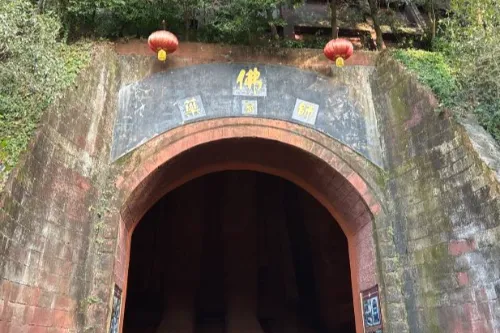
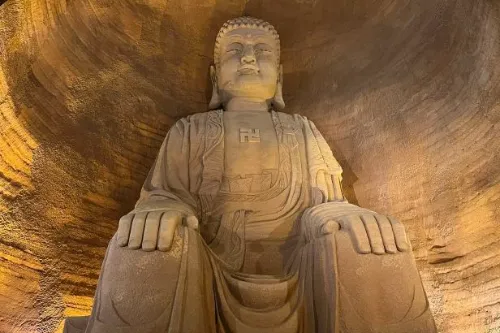
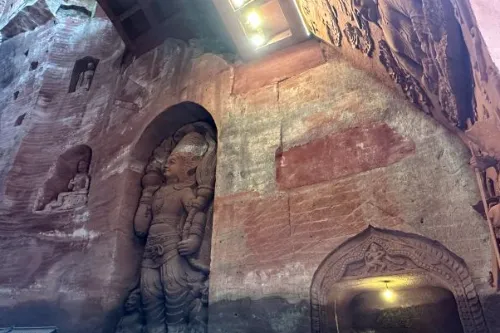
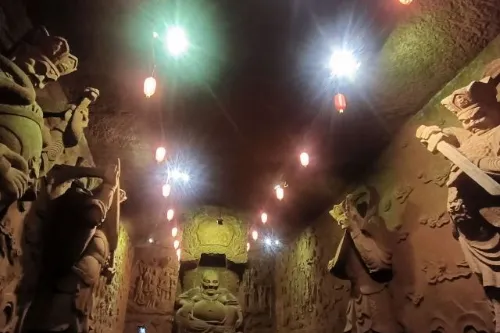
Giant Buddha Bay
Surrounded by peaks on three sides, the Giant Buddha Bay has three tiers of temples descending vertically, shaped like a dragon throne. In the center of the grotto hall stands China's only double-stone-pillar Xinche Grotto. The doorways are designed based on the Buddhist concept of "Three Liberation Gates" (Gate of Emptiness, Gate of Heavenly Appearance, Gate of Heavenly Creation). Between the doorways, there are reliefs of Bodhisattvas, and around the door corridors, there are shallow carvings of Dunhuang Apsaras. It has a unique artistic style.

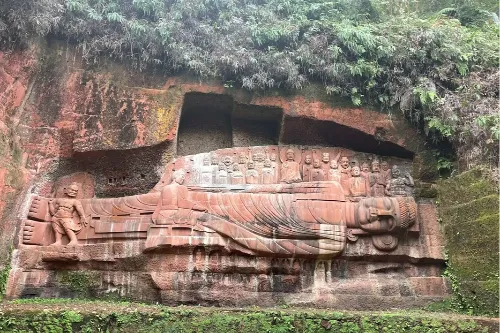
Giant Reclining Buddha
With a total length of 170 meters, the Giant Reclining Buddha is modeled after the Dazu Rock Carvings. It is built according to the mountain's terrain: the head is carved at the southern end, the feet at the northern end, and the natural vegetation in the middle is preserved, making it look like Sakyamuni Buddha in nirvana covered with green vegetation. The Buddha's head is 24 meters long and 32.7 meters wide, its mouth is 4.5 meters wide, and it has 115 hair buns (each with a diameter of 1 meter). The instep is 10.2 meters wide. Above the head, there is a carving of "two dragons playing with a pearl", presenting a magnificent momentum.
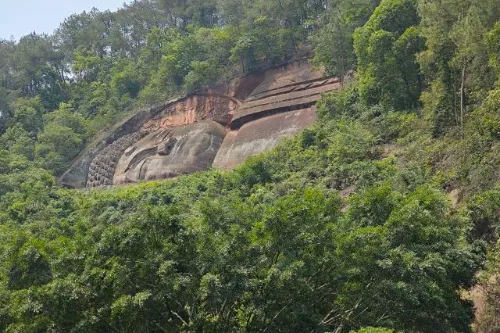
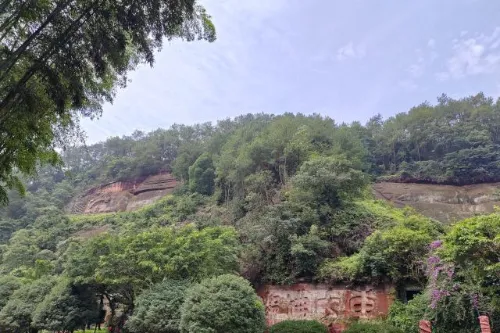
Demon-Subduing Pool
Also known as "Buddha Subduing Demonesses", the Demon-Subduing Pool recreates the scene where the devil sent three jade maidens to tempt Sakyamuni when he was becoming a Buddha. Among the statues here, the main Buddha statue is the only work of Liu Kaiqu, the founder of Chinese sculpture, before his death. It was praised by Zhao Puchu as "the final dignity of life". The Buddha statues on both sides, dating from the Northern Wei Dynasty to the Song Dynasty, are a microcosm of the history of Chinese Buddhist culture.
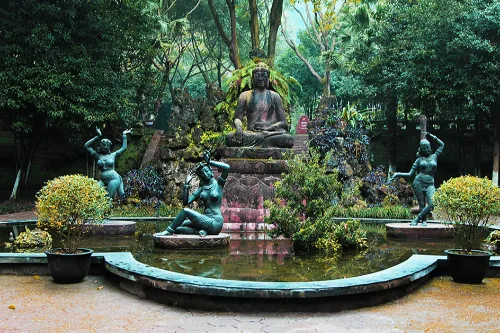
Lianxin Mountain (Heart-Connecting Mountain)
As a popular attraction in the Giant Buddha Bay, Lianxin Mountain has 173 stone steps, and there is a Burning Lamp Buddha statue at the top. Dense heart-connecting locks, longevity locks and prosperity locks are hung on steel pillars and iron chains, carrying the wishes of tourists for blessing. It is an important node for cultural experience in the resort.
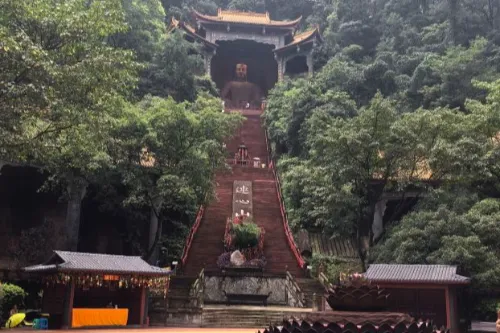
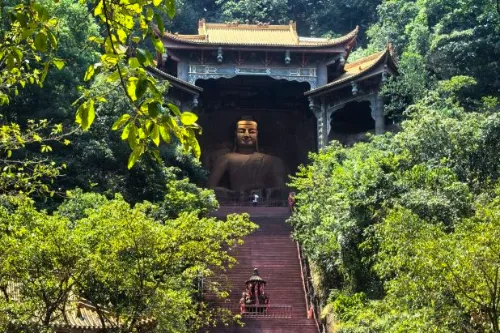
Tour Route
Recommended Route: Enjoy the panoramic view of the 173-meter open-air Reclining Buddha at the entrance → Cross the bridge to enter the Ten Thousand Buddha Grotto (visit the six parts of the grotto in sequence) → Appreciate the Double-Pillar Grotto and Apsaras reliefs in the Giant Buddha Bay → Learn about the sculptural history of Liu Kaiqu at the Demon-Subduing Pool → Hang a lock to pray for blessings at Lianxin Mountain → Taste Leshan snacks at the exit. The whole journey takes about 2.5 hours on foot, and it is recommended to combine the tour with the Leshan Giant Buddha.
Travel Tips
- Wear non-slip shoes as there are many stone steps in the resort; take sun protection measures in summer, and prepare a thin coat as the grottoes are relatively cool.
- It is recommended to rent an audio guide (20 yuan per unit) or follow the resort's official WeChat account to get free explanations and learn about the historical allusions behind the Buddha statues.
- The morning light is the best for taking photos of the open-air Buddha statues; you can visit the Underground Palace in the afternoon to avoid the peak of tourist groups.
- For a combined tour with the Leshan Giant Buddha and Wuyou Temple, it is recommended to reserve half a day. There are sightseeing buses directly to the Leshan Giant Buddha at the resort exit (10 yuan per person).
Notes
- Using flash photography is prohibited in the grottoes to avoid damaging the colored paintings on the Buddha statues; some areas are slippery, so please watch your step.
- Respect Buddhist culture: do not climb on the Buddha statues or make loud noises; smoking is prohibited in enclosed areas such as the Underground Palace.
- There are many vendors around the resort. It is recommended to choose shops with clearly marked prices when buying local specialties. For snacks like Boboji (spicy skewers), the time-honored brands "Ye Popo" and "Gu Zhenji" are recommended.
- Some mountain roads may be closed during the rainy season (June-September), so please check the weather forecast before traveling; the Underground Palace is relatively cold in winter, so it is recommended to bring a scarf and gloves.
Transportation
- Bus: Take Bus No. 3 or 13 in Leshan City to the "Oriental Buddha Capital" stop, then walk 50 meters to the resort entrance.
- Self-Driving: Navigate to "Oriental Buddha Capital". The resort parking lot can accommodate more than 200 vehicles, with a charge of 10 yuan per hour.
- High-Speed Rail: After getting off at Leshan Railway Station, it takes about 20 minutes by taxi to reach the resort; it takes about 35 minutes by taxi from Emeishan Railway Station.
- Intercity Bus: Take a direct bus from Chengdu Xinnanmen Bus Station to Leshan (about 1.5 hours), then transfer to Bus No. 3 to the resort.
Opening Hours
The resort is open from 07:30 to 18:00 (admission stops at 17:30). In summer (June-August), the closing time is extended to 18:30; in winter (December-February), the opening time is adjusted to 08:00. The hours may change during special events, so it is recommended to call and confirm before traveling.
Ticket Information
The ticket price is 80 yuan per person. The actual price shall prevail at the resort.
You can search for the official WeChat account "东方佛都" to get the latest updates.
You can search for the official WeChat account "乐山大佛景区" to buy tickets online.
Online Booking
Click here to jump to the Trip.com ticketing platform for ticket purchase.


